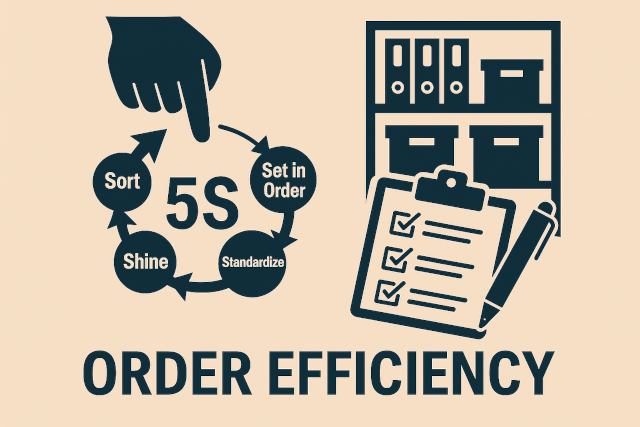It’s easy to tidy up a warehouse once—but it’s hard to keep it that way. That’s the core challenge of 5S: sustainability. And the secret to sustaining 5S is the 5S audit—a structured, repeatable way to track progress, hold teams accountable, and identify areas for improvement.
Whether your distribution center is new to Lean or you’re years into your 5S journey, audits are essential to avoid backsliding into chaos. In this article, you’ll learn how to set up and run 5S audits that are fair, consistent, and actually drive results—without making your team feel like they’re being policed.
Why Audit? The Purpose Behind the Process
5S audits aren’t about fault-finding. They’re about:
- Reinforcing good habits
- Identifying training or process gaps
- Maintaining safety standards
- Creating visual feedback loops
- Celebrating improvement over time
Think of 5S audits as both a mirror and a map: a mirror to reflect where you are now, and a map to guide where you want to be.
What Should a 5S Audit Include?
A good audit evaluates each “S” individually, allowing you to see where you’re excelling and where you need work. For example, a high score in Shine but low in Standardize shows the area is clean but lacks systems to keep it that way.
Here’s what to assess in each category:
1. Sort
- Are unnecessary items removed from workspaces?
- Are only essential tools and materials present?
- Are red-tagged items removed promptly?
2. Set in Order
- Is everything clearly labeled and stored logically?
- Are tools and parts returned to the same place after use?
- Are materials arranged for easy access and flow?
3. Shine
- Are floors, equipment, and surfaces clean?
- Are cleaning tools available and used daily?
- Are defects, leaks, or damage identified during cleaning?
4. Standardize
- Are there visual standards (photos, checklists) for organization?
- Are procedures documented and visible?
- Do different shifts maintain similar conditions?
5. Sustain
- Are audits done regularly and taken seriously?
- Is 5S included in training and meetings?
- Are teams praised and coached based on results?
Scoring the Audit: Keep It Simple and Visual
Use a numeric scale (typically 1 to 5) with clear definitions for each level. Example:
| Score | Description |
| 1 | No evidence of 5S principles |
| 2 | Some effort, inconsistent application |
| 3 | Basic 5S in place, but not maintained |
| 4 | Good application, mostly consistent |
| 5 | Full application, clearly sustained |
To make it easier to interpret scores, color-code them like a heat map:
- Red = 1–2
- Yellow = 3
- Green = 4–5
This allows managers and frontline teams to instantly see how each area is performing.
Choosing Auditors and Audit Frequency
A 5S audit is most effective when it’s owned by the team—not just supervisors. Involve employees from different areas, shifts, or departments to conduct audits on a rotating basis. This:
- Builds a deeper understanding of 5S
- Creates cross-functional learning
- Reduces bias or complacency
Suggested frequency:
- Start with weekly audits in high-traffic zones
- Move to biweekly or monthly as habits improve
- Conduct surprise “mini-audits” occasionally
You can use paper checklists, Excel-based audit forms, or even mobile apps like iAuditor or GoAudits for digital tracking.
What to Do With the Results
An audit is only useful if you take action. Here’s what to do:
1. Score and Record
Keep a historical log for each area so you can track trends and improvements.
2. Visualize the Data
Post results on team boards or dashboards. Use graphs, before-and-after photos, and improvement charts. This transparency builds engagement and pride.
3. Assign Follow-Up Tasks
If an area scores low in Shine or Set in Order, assign clear actions with owners and deadlines.
4. Share Wins
Recognize top-performing teams in meetings, newsletters, or with simple rewards like morning tea or badges. A bit of fun goes a long way in keeping people motivated.
Common Mistakes to Avoid
Running 5S audits isn’t foolproof. Watch out for these pitfalls:
- Overcomplicating the process: Don’t turn it into a 20-page checklist.
- Inconsistent scoring: Train all auditors to apply the same standards.
- Focusing only on numbers: A score of 4 with no engagement is less valuable than a 3 with active improvement.
- Not acting on findings: If nothing happens after an audit, teams will stop taking it seriously.
Example: Audit in Action
Let’s say you’re auditing a packing zone in a distribution center. Here’s what you might observe:
- Tools are scattered across the bench (Set in Order = 2)
- The floor is clean and swept (Shine = 4)
- Labels on storage bins are faded (Standardize = 3)
- Red-tagged parts have been sitting for a week (Sort = 2)
- Employees don’t know where to find the 5S checklist (Sustain = 2)
Now you have a picture of the area’s 5S health—and a list of real actions to improve it.
Wrapping Up: Make 5S Audits a Culture, Not a Chore
A 5S audit shouldn’t feel like a test. Done right, it’s a conversation starter—a chance to celebrate what’s working and fix what’s not. It shows your team that order matters, that standards matter, and that their work environment deserves care and attention.
Start small. Be consistent. And always treat audits as a learning opportunity—not a scorecard of shame.
As your audits evolve, so will your workplace. Over time, you’ll find that 5S isn’t just something you do—it’s who your team becomes.



